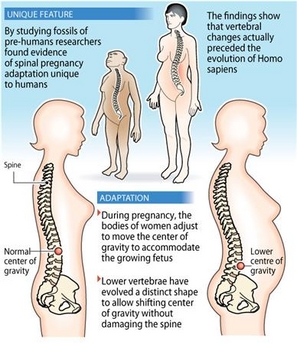Pregnant? Backache? Thank evolution
(Agencies)
Updated: 2007-12-14 16:23
Updated: 2007-12-14 16:23
WASHINGTON - Pregnant women may stand out a mile away with their characteristic backward-leaning stance, but that clumsy-looking position is a unique adaptation that evolved over millennia, anthropologists said on Wednesday.
Pregnant pre-humans appeared to have stood the same way. And it may save women from even more back pain than they already have, the researchers report in this week's issue of the journal Nature.
The bodies of women do two things when they are pregnant - they adjust their stance to move the center of gravity to accommodate the growing fetus, and the lower vertebrae have evolved a distinct shape to allow this shifting to take place without damaging the spine, Katherine Whitcome of Harvard University and colleagues found.
"It was one of these things like, 'Oh my god, no one's ever thought of this,' and it looks so obvious," Liza Shapiro of the University of Texas at Austin, who helped supervise the work, said in a telephone interview.
Whitcome and Shapiro followed 19 women through their pregnancy, using digital cameras and motional analysis equipment to map the changes in stance and movement as the months passed.
"What women do when their pregnancy reaches about half of the expected mass ... they shift backwards," Shapiro said.
"If you didn't have any of those mechanisms, the only way to offset a load in front of you is to contract your back muscles. The more you have to use your muscles, the more discomfort you would have. It would be worse otherwise, and there would be more potential damage to the vertebrae."
Without this change in shape, the vertebrae could be subject to shearing forces, with one sliding over another, damaging the fluid-filled discs in between or pulling on ligaments and muscles.
"The shape of the vertebrae allows her to rotate the upper body," Shapiro said.
When she moved to Harvard, Whitcome continued the study and looked at the fossils of pre-humans known as australopithecines, as well as at the bone structure of our nearest living relatives, the chimpanzees.
"These differences are absent in the chimpanzee. So there is something unique about humans," Whitcome said. "We also see some evidence for these adaptations in early australopithecines."
Men do not have this adaptation, either, Shapiro said.
"We can only conclude that men can't resist the forces of their big bellies as well as women. They are at a disadvantage," she said.
"They probably lean back the same way to try and balance that load, but they are kind of putting their vertebrae more at risk. I am sure there has got to be a correlation between having a big beer gut and having back pain," Shapiro laughed.
|
|
|
||
|
||
|
|
|
|
